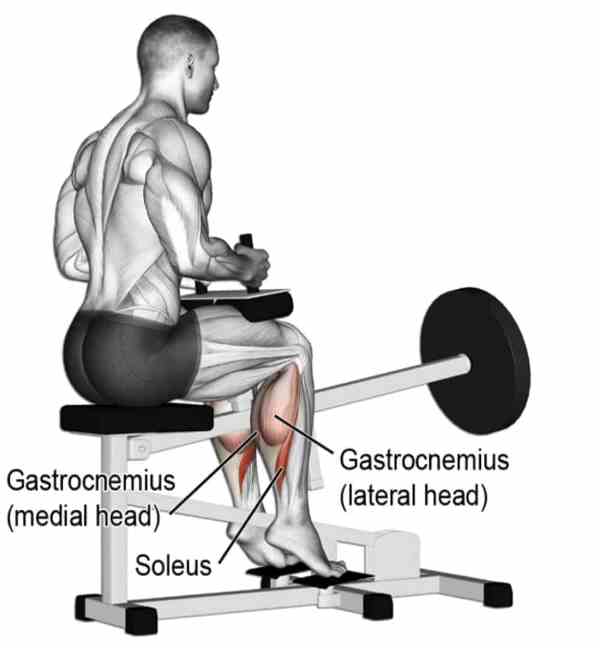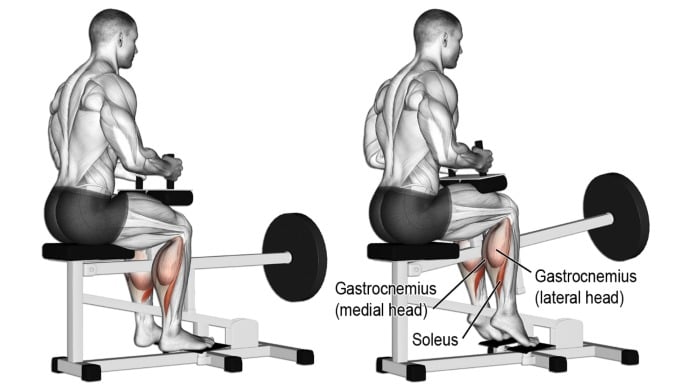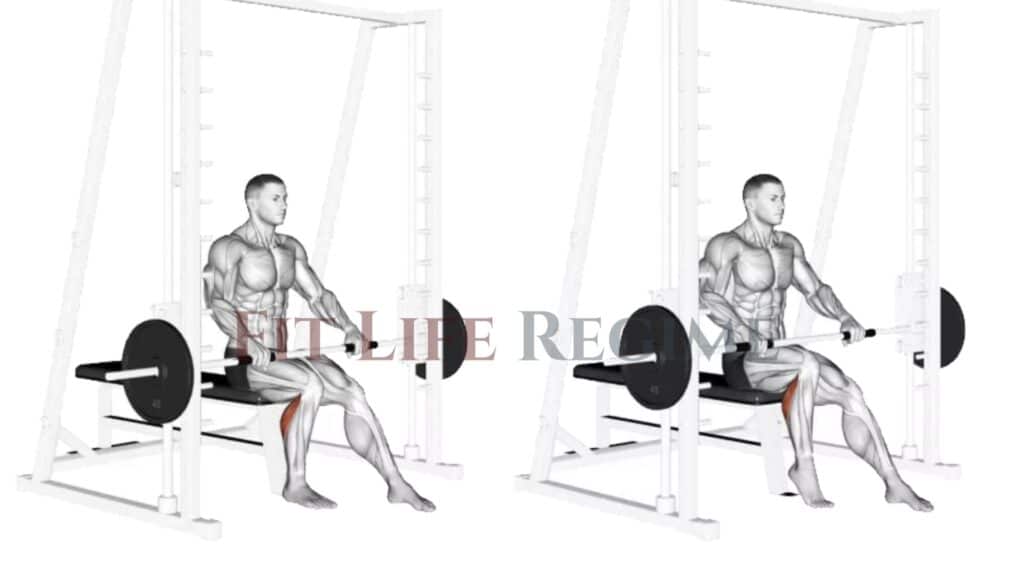A seated calf raise primarily targets the calf muscles (soleus and gastrocnemius). It is performed while seated, with the feet on a platform and the weight on the thighs. The movement involves lifting the weight by extending the ankle and lowering it by flexing it.
A machine is often used to perform seated calf raises. This machine supports the knee, allowing for a more controlled and isolated movement of the calf muscles. Additionally, you can adjust the weight and angle of the foot platform.
It can also be done with a barbell or a dumbbell seated on a bench.
If you haven’t tried the seated calf raise, I highly recommend it. It’s a simple yet highly effective exercise that can significantly impact your lower leg training.

- Seated Calf Raises Muscles Worked
- How To Do Seated Calf Raise
- Tips and Form
- 5 Best Variations of Seated Calf Exercise
- 1. Seated Dumbbell Calf Raise
- 2. Seated Machine Calf Raise
- 3. Seated Dumbbell One-Leg Calf Raise
- 4. Barbell Seated Calf Raise
- 5. Seated Smith Machine Calf Raise
- FAQs
- How many sitting calf raises should I do?
- Are seated calf raises better than standing?
- How to Do Seated Calf Raises at Home?
- References
Seated Calf Raises Muscles Worked
Seated calf raises primarily target the soleus muscle, which is a uni-articular muscle located under the gastrocnemius.
The gastrocnemius muscle is the larger and more superficial of the two. It creates the calf’s “bulging” appearance. It is also involved in plantar and knee flexion and serves as a secondary muscle target when performing seated calf raises.
Because the knee is held in a fixed position during this exercise, the gastrocnemius cannot fully contract, which allows the soleus to be the primary muscle worked.

How To Do Seated Calf Raise
- Locate a seated calf raise machine at your gym, or use dumbbells and barbells if a calf machine is not available.
- Adjust the seat height and footplate position to ensure proper alignment and comfort.
- Sit on the machine with your back straight and feet resting on the footplate.
- Position the balls of your feet on the edge of the footplate, with your heels slightly hanging off.
- Place your hands on the handles or sides of the machine for stability.
- Engage your core and maintain an upright posture.
- Slowly lower your heels by flexing your ankles, allowing them to drop below the footplate.
- Pause briefly at the end of the movement to stretch your calf muscles.
- Contract your calf muscles and raise your heels as high as you can by extending your ankles.
- Squeeze your calf muscles at the top of the movement for a second.
Tips and Form
- Focus on a slow and controlled tempo, such as a 3-second eccentric (lowering) phase, a pause at the bottom, a 3-second concentric (lifting) phase, and a pause at the top.
- Keep your heels up as you raise your seated calf to avoid releasing tension when your heels touch the ground.
- Strengthen the mind-muscle connection and make the calves’ workout more effective and focused.
- Avoid leaning back or compromising your posture during seated calf raises. Sit upright with a neutral spine and engaged core.
- During the exercise, focus on pressing through the balls of your feet instead of your toes.
- Experiment with different toe positions (straight, slightly outward, or inward) to target different areas of your calf muscles
- Imagine sitting at a 90-degree angle and keeping this position to avoid strain on the lower back and maximise calf muscle engagement.
- Perform seated calf raises with a full range of motion. Lower your heels as far as possible and raise them as high as possible, while maintaining control and proper form.
- Do not turn your feet excessively. Ensure your feet are aligned with your legs and avoid inward or outward rotation.
- The soleus muscle, primarily composed of slow-twitch muscle fibres, can tolerate more frequent training than other muscle groups.
5 Best Variations of Seated Calf Exercise
Look at these 5 Best seated calf raises workouts and training exercises for the best calves.
1. Seated Dumbbell Calf Raise
If you are looking for a calf raise exercise that you can do at home or in the gym, seated dumbbell calf raises are perfect for training the soleus calf muscle.
When performing the seated version of calf raises, it’s essential to achieve a good stretch at the bottom and squeeze at the top. That way, you will hit every muscle fiber available.
Sometimes it’s challenging to get a good pump in the calf muscle, so be sure to add enough weight and repetitions.

How To Do Seated Dumbbell Calf Raise
- Use a seated calf raise machine or sit on a bench.
- Rest the balls of your feet on a block or plates, and hold dumbbells on your thighs for resistance.
- Your knees should be bent 90 degrees, and your toes should be pointing straight ahead.
- Allow your heels to drift toward the floor until you feel a stretch in your calves.
- Now, drive the balls of your feet into the platform and raise your heels as high as possible.
- Move slowly as you stretch your calf muscle.
- Ensure you hold the stretch for a second at the top, then return to the starting position.
2. Seated Machine Calf Raise
The seated machine calf raise is one of the most effective exercises for building calf strength.
The isolation of the calf movement and the seated supported position enables lifting significantly heavier loads than other calf raise variations, such as standing or donkey calf raises.
It specifically activates and stresses the soleus calf muscle; therefore, the exercise is best performed with the knees at a 90-degree angle.

How To Do
- Sit in the seated calf machine and place your feet on the foot plate so that your heels hang off the edge.
- Place the knee pad on your knees and unrack the weight.
- Drop your heels as low as possible to achieve a good stretch in your calves.
- Lift your heels by contracting the calf muscles to raise the weight as high as you can on the balls of your feet.
- Hold this position for a second, flexing your calf muscles, then lower your heels back to the starting position.
- To achieve the maximum range of motion, raise your heels as high as possible.
3. Seated Dumbbell One-Leg Calf Raise
The seated dumbbell one-leg calf raise exercise places more stress on the soleus than it does on the gastrocnemius.
It may also be performed with both legs simultaneously, but it is recommended that you do it one leg at a time to execute it properly and safely.
If your calves differ in size and strength, perform this exercise first on your smaller or weaker calf, and do not perform more reps on your stronger calf. This allows your weaker calf to catch up in strength.

How To Do
- Sit with the front of your right foot placed on top of a block or step in front of you.
- Hips and knees should be bent at a ninety-degree angle.
- Dip the heel of your right foot as low as it can go.
- Hold a dumbbell vertically on top of your right knee.
- Exhale as you lift your right heel as high as possible, pushing against the weight of the dumbbell.
- Keep your right heel lifted for 2 counts. Slowly lower it as you inhale.
- Repeat the desired number of repetitions.
- Then repeat the exercise on your left foot.
4. Barbell Seated Calf Raise
The barbell seated calf raise is an excellent variation of the seated calf raise, particularly suitable for those with limited equipment (e.g., a home setup). However, you can still utilise it as a gym exercise.
This is a beneficial exercise if you don’t have access to a seated calf-raise machine.
How To Do
- Sit on the end of a bench or chair and place the barbell on the back of your thighs near your knee but not on your knee.
- You can use a padded barbell for comfort or place a cushion on your thighs if needed.
- Sit up straight and place the top half of your feet or the balls of your feet on the floor or an elevated object so that your heels hang off.
- Have a firm grip on the barbell to keep it in one place.
- Lift your heels by contracting the calf muscles to raise the weight as high as you can on the balls of your feet.
- Hold this position for a second, flexing your calf muscles, then lower your heels back to the starting position.
- Perform the reps slowly and with a full range of motion.
- One technique that has helped me maximize my calf development is using a slower eccentric (lowering) phase. I’ve found that taking 3-4 seconds to reduce the weight allows.
5. Seated Smith Machine Calf Raise
The Smith machine calf raise is an effective way to make your lower legs appear larger and thicker than just doing regular bodyweight calf raises.
This machine-based exercise primarily targets the gastrocnemius or upper calf muscle, with supporting muscles including the soleus and tibialis anterior.

How To Do
- Set up the Smith machine seated calf raise by placing a flat bench in the Smith machine and putting a step or foot flat on the floor.
- Sit at the end of the bench and place the ball of one foot on the floor. Take the bar off the rack and rest it on your right thigh.
- Lift your heel of the right foot by contracting the calf muscles to raise the weight as high as you can on the balls of your feet.
- Hold this position for a second, flexing your calf muscles, then lower your heels back to the starting position.
FAQs
How many sitting calf raises should I do?
As a general guideline, start with 2-3 sets of 12-15 reps of calf raises, using a weight that allows you to perform the exercise with proper form while still challenging your muscles.
You can gradually increase the weight and/or reps as you get stronger and your muscles adapt to the exercise.
For beginners, it’s essential to start with a comfortable weight and avoid pushing too hard.
Are seated calf raises better than standing?
It’s challenging to determine which exercise is more effective, as it depends on the individual’s goals and muscle strength.
If you’re looking to target and strengthen your soleus muscle, a seated calf raise will be more beneficial, whereas a standing calf raise will be more beneficial if you’re looking to target and strengthen your gastrocnemius muscle.
Including both exercises in your workout routine is recommended to target both muscle groups and get the most benefits.
How to Do Seated Calf Raises at Home?
You can do seated calf raises at home using a chair and a heavy object on your knees. Home workout enthusiasts have been known to use water jugs or books, while dumbbells and weight plates are the more standard options.
References
- ACE: “Weight Lifting Tempo & Sets: How to Select the Right Sets for Your Clients”
- Lee, Geoncheol et al. “The Effect of Calf-Raise Exercise on Gastrocnemius Muscle Based on Other Type of Supports.” (2014).
- Lee, Geoncheol & Kim, Bom & Kim, Jisu & Nam, Inseong & Park, Yoojin & Shin, Woojin & Woo, Sumin & Cha, Seongki. (2014). The Effect of Calf-Raise Exercise on Gastrocnemius Muscle Based on Other Type of Supports. Journal of The Korean Society of Integrative Medicine. 2. 10.15268/ksim.2014.2.1.109.

Manish is a NASM-certified fitness and nutrition coach with over 10 years of experience in weight lifting and fat loss fitness coaching. He specializes in gym-based training and has a lot of knowledge about exercise, lifting technique, biomechanics, and more.
Through “Fit Life Regime,” he generously shares the insights he’s gained over a decade in the field. His goal is to equip others with the knowledge to start their own fitness journey.
